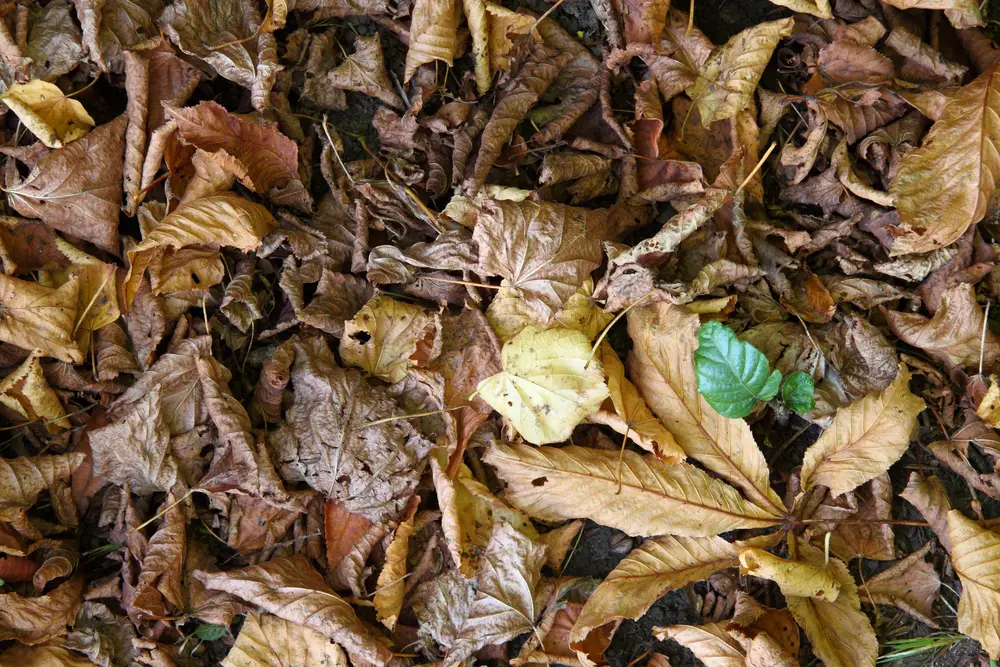So, what is leaf mold? To clarify, leaf mold is not the same as moldy leaves. The former is an excellent conditioner for garden soil and will add vital elements to it. The latter is likely some kind of plant disease.
Leaf mold is essentially fungus decomposing leaves. Whereas any number of microscopic bacteria may break down the leaves in your compost pile, leaf mold is a specific organic process where fungus breaks down the leaves.
For leaves to attract fungal growth, they need to be in a cool, damp, and undisturbed space. In your garden, you can make a simple system to create leaf mold in a year or two. In nature, the breakdown of fallen leaves into leaf mold can take much longer.
Where To Find Leaf Mold

Leaf mold is a vital part of forests. The forest’s deciduous trees (the trees that have leaves that fall, not evergreen nettles) drop leaves that pile up on the ground and are left undisturbed in the shade of the forest. This puts them in cool, damp conditions that attract local fungi and earthworms.
Over a period of years, the leaves turn into a dark, clay-like organic material called humus. That humus, in turn, provides nutrition to the tree that created it in the first place. This decomposition process is very valuable in nature and is a prime example of decay being a key element of growth.
If you want to add a quick nutrition boost to your garden and there is a nearby accessible forest, searching the forest floor for leaf mold and humus is an option.
Be careful if you choose to harvest from a forest, though. Make sure to leave plenty of soil for the nearby trees. Only harvest from a forest if you are knowledgeable about the ecosystem and will not disturb wild plants.
Harvest leaf mold at least thirty feet from any roads or powerlines. Soil surrounding development areas and the subsequent plants that grow from that soil are often contaminated with heavy metals. Only harvest in areas where you know the history of the land and the proper protocols.
Using Leaf Mold In Your Garden
Leaf mold, when added to your garden bed, helps with the structure of the soil. This allows your garden bed to hold more water and create a more airy, less dense soil. Dense soil is difficult for a plant’s roots to grow into deeply and easily.
Leaf mold keeps your soil healthy and attracts earthworms and beneficial fungi.
Growing Your Own
Consider making your own at home instead of taking leaf mold from forests. It is a good use of fallen leaves in autumn and is a more sustainable long-term option.
Steps
Collect fallen leaves from around deciduous trees in your own yard, or visit a public park in the fall and collect leaves from there. As a side note, dead leaves are very good for your garden, and using them for that purpose is pretty easy, too. When collecting leaves from public spaces, check in with your local park or city employees. Fallen leaves stuck in gutters and near busy streets may be polluted and are best to avoid.
One barrier to growing your own leaf mold is that it takes a long time for newly fallen leaves to decompose into that rich, earthy humus.
To speed up the process, shred the fallen, dried-up leaves with your lawn mower. The smaller pieces will decompose faster than whole leaves.
Place your leaves into a container. This could be anything from a wooden box to a plastic bag. Wet the leaves thoroughly so the whole pile is damp throughout. Place the container in a shady place to help retain the dampness, and check on the leaves every few months to be sure the leaves have not dried out. Two years after building your pile, the shredded leaves should be transformed into humus.
Till the fresh humus into your garden before or after the growing season to help the structure of your soil, or spread it on top of your soil to use as temperature-regulating mulch.
Another option for homegrown leaf mold that has been left for at least two years is using the decomposed material to fill seed-sowing containers. Mix the leaf mold with other organic materials like kitchen compost, and you will have good-quality soil for seed starts.
My Experience With Leaf Mold
I make my own leaf mold in the community garden where I help out in the summer, and I have been doing it for a few years (if you’d like to do the same, we’ve got tips and resources for finding a community garden near you). I have two wire-mesh leaf containers so I can use one container-full in the garden beds every year, and the second container will sit for another year. The empty container then gets refilled with new shredded leaves.
I have found it quite easy to keep the leaves constantly damp. In my experience, the pile does not require much watering. I live in an area with cold, wet winters. So, for the winter season, I do not tend to the leaf mold at all, and it works out just fine.
The whole pile freezes at cold enough temperatures, slowing down the decomposition process. This is one of the reasons I have chosen to let my leaves decompose for two years instead of just one.
The only time of year I am concerned about the leaves’ moisture is the height of summer when it is very hot and dry. I try to check on the leaves every few weeks in the summertime. If the pile’s interior is not squishy and damp to the touch, I water it.